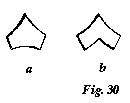VII. GOTHIC PALACES 297
The balcony is, of course, modern, and the series of windows has been of greater extent, once terminated by a pilaster on the left hand, as well as on the right; but the terminal arches have been walled up. What remains, however, is enough, with its sculptured birds and dragons, to give the reader a very distinct idea of the second order window in its perfect form. The details of the capitals, and other minor portions, if these interest him, he will find given in the final Appendix.1
§ 31. The advance of the Gothic spirit was, for a few years, checked by this compromise between the round and pointed arch. The truce, however, was at last broken, in consequence of the discovery that the keystone2 would do duty quite as well in the 
1 [Vol. XI. App. 10. Other details from this house are given in Plates 10 and 11, Vol. IX.]
2 [See Vol. IX. Plate 3, Figs. r and s, and p. 173, where also the development of the keystone is illustrated.]
3 [The Cannareggio is the broad canal which strikes out of the Grand Canal to the north-west, a short distance east of the railway station.]
[Version 0.04: March 2008]